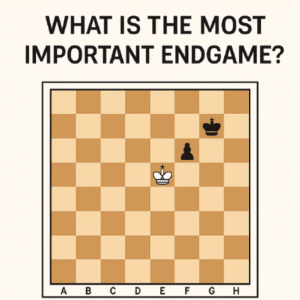The most important endgame in chess is the key to victory.
♟️ Which Endgame Is the Most Important?
Chess is not only about beautiful combinations and openings — every game eventually comes down to the endgame.
Many players underestimate this stage, calling it boring or “technical.” But this is exactly where real mastery shines through. One precise move can decide the entire game.
So which endgame is considered the most important? Let’s break it down step by step.

🏁 What Is an Endgame?
The endgame (from the German Endspiel — “final game”) is the stage when there are only a few pieces left on the board.
Kings come out of hiding, pawns become incredibly valuable, and every move brings you closer to victory — or to a draw.
The main goal of the endgame is to promote a pawn to a queen or use the activity of the king to outplay your opponent.
👑 Why the Endgame Is the Most Important Part of Chess
In the opening, you can follow theory; in the middlegame, you can create combinations — but in the endgame, everything depends on understanding the logic of positions.
Mistakes are unforgivable here, and every detail — the activity of the king, pawn structure, and proper opposition — matters.
Even the greatest grandmasters admit: mastering the endgame is the true sign of a strong chess player.
⚔️ Types of Endgames
All endgames can be grouped by the remaining pieces:
- Pawn endgames — only pawns and kings.
- Rook endgames — the most common and the most complex.
- Bishop vs Knight or same-piece endgames — strategic and subtle.
- Queen endgames — dangerous and unpredictable, often ending with perpetual check.
🌟 The Most Important Endgame: Pawn Endgames
If you have to choose one endgame to know better than any other, it’s the pawn endgame.
Why?
Because almost every complex endgame eventually simplifies into a pawn endgame.
After exchanges, only pawns remain on the board, and everything depends on their advance, the activity of the king, and knowledge of key positions.
What You Must Know in Pawn Endgames:
- Opposition — using your king’s position to restrict your opponent.
- The Rule of the Square — helps you quickly see whether a king can catch a pawn.
- Passed Pawn — your main weapon in the endgame.
- King Activity — the king becomes a fighter, not just a defender.
🧠 Example: The Power of the Pawn Endgame
Imagine a position where both players have only a king and three pawns on one side of the board.
It looks like a draw, right? But the player who activates the king first and creates a passed pawn wins.
One timely move can turn the entire game around.
💡 How to Improve Your Endgame Skills
- Study the classics — the books by Capablanca and Dvoretsky are gold standards.
- Practice typical positions — opposition, queen vs pawn, rook draws.
- Analyze your own endings — that’s where you’ll see where points slip away.
- Play short games focused on endgames — this helps develop positional intuition faster.
🏆 Conclusion: The Key to Victory Lies in the Final Stage
The endgame is not just “cleanup play” — it’s an art of precision and calculation.
The most important endgame every chess player must master is the pawn endgame.
Once you understand it, you’ll grasp the logic behind all other endings and learn how to win even the toughest positions.
♟️ In chess, as in life, victory belongs to those who know how to finish what they start.